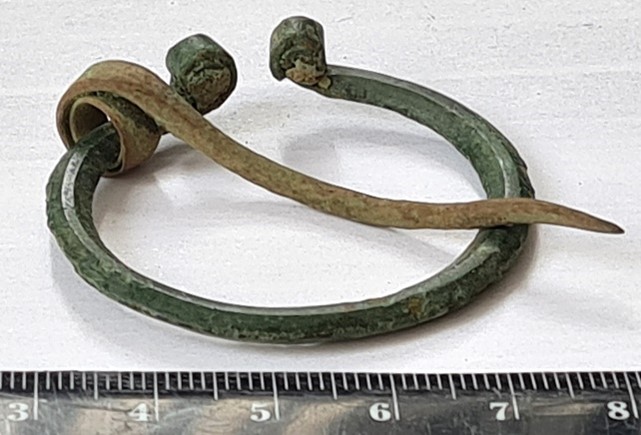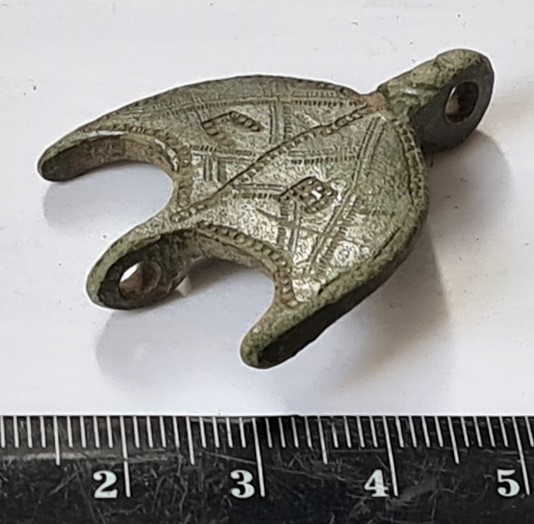Database
Our database is free to use for all history and archaeology enthusiasts. If you use our database, please do not forget to cite correctly:
Mägi, Marika; Palm, Piia Sandra. Archaeological Artefacts of Saaremaa. Foundation Osiliana / Tallinn University. Accessed: date.
The Osiliana Archaeological Database presents artefacts from Saaremaa and the surrounding small islands.
The database contains mainly Iron Age and Medieval finds that can be classified.
Undated metal or other pieces were generally excluded from the database.
Ceramics are represented by isolated examples.
The database is a work in progress and is constantly being updated.
Kingli
Buckle, bronze. Round fronted ladies’ buckle. They were attached at either end of the belt and fastened together with, for example, an iron or bronze hook. Typical of 13th-century inhumations in Saaremaa and coastal Estonia, but sometimes found in stone graves as well.


Buckle, bronze. Round fronted ladies’ buckle. They were attached at either end of the belt and fastened together with, for example, an iron or bronze hook. Typical of 13th-century inhumations in Saaremaa and coastal Estonia, but sometimes found in stone graves as well.
Kõiguste
Penannular brooch, copper alloy. Rolled terminals, the cross-section of the ring is hexagonal, almost rhombic, the pin is narrow.

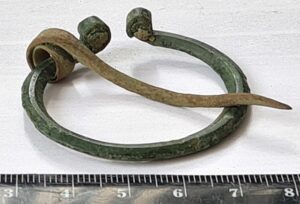

Penannular brooch, copper alloy. Rolled terminals, the cross-section of the ring is hexagonal, almost rhombic, the pin is narrow. Judging by the size and shape of the cross-section of the ring and the pin, it should belong to the second or first half of the 10th or 11th century. Similar ones can be found for example from Laukskola, burial no. 304 (Zariņa 2006, Pl 197: 2).
Literature:
Zariņa, A. 2006. Salaspils Laukskolas kapulauks 10.–13. gadsimts. Rīga: Latvijas Vēstures Institūta Apgāds.
Kõiguste
Crossbow brooch, bronze. With transversal cross-sections. Quite a number of such brooches have been found on the Estonian mainland.

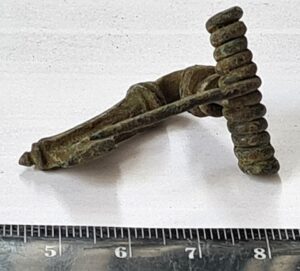


Crossbow brooch, bronze. With transversal cross-sections. Quite a number of such brooches have been found on the Estonian mainland. Most likely from the 4th or early 5th century (Lang 2007, 207-208).
Literature:
Gustin, I. 2004. Mellan gåva och marknad. Handel, tillit och materiell Kultur under vikingatid. – Lund Studies in Medieval Archaeology, 34. Malmö, Almqvist & Wiksell, 100-107.

Kõiguste
Penannular brooch, copper alloy. Straight-drawn ring, only one rolled terminal left intact. The cross-section of the ring is rhomb.
Tõnija Põlluküla
A comb-shaped pendant with a cruciform top and a bell, bronze. With ornate lines and cross-branches have concentric circles. Unlike most pendants of this type, the comb-shaped part has three holes, one of which has a small bronze bell attached by a ring. The bell is spherical, with a cruciform opening and a ball inside.



A comb-shaped pendant with a cruciform top and a bell, bronze. With ornate lines and cross-branches have concentric circles. Unlike most pendants of this type, the comb-shaped part has three holes, one of which has a small bronze bell attached by a ring. The bell is spherical, with a cruciform opening and a ball inside. Judging by the analogues, such cross-shaped pendants could belong to the second half of the 10th century or the first half of the 11th century, possibly the whole of the 11th century (for analogues, Kurisoo 1999).
Tõnija
Chain holder, bronze. Semi-oval, with three branches, but only the middle branch has a loop. There is some kind of relief ornament on the front of the upper branch, but it is not possible to say whether it could have been in the form of a human face, as some of the chain holders of this type have.
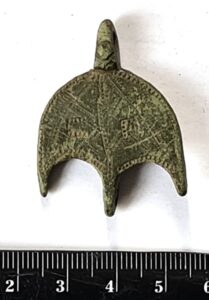


Chain holder, bronze. Semi-oval, with three branches, but only the middle branch has a loop. There is some kind of relief ornament on the front of the upper branch, but it is not possible to say whether it could have been in the form of a human face, as some of the chain holders of this type have.
Valjala
Pendant, bronze. Rhombus-shaped, ornamented with fluted lines, one end profiled with lines.



Pendant, bronze. Rhombus-shaped, ornamented with fluted lines, one end profiled with lines. Similar to those cross pendants with rhombus-shaped central parts from Siksälä are dated to the 14th-15th century (Valk et al 2014, 79, 103, 197, 298).
Literature:
Valk, H., Ratas, J., Laul, S. 2014. Siksälä kalme II. Matuste ja leidude kataloog. Tartu Ülikool: Tartu.
Lõve/Sakla
Bells, 2, iron. Square-shaped, with a large loop. Probably from the side of the harness. Such finds are common in late prehistoric stone graves.


Bells, 2, iron. Square-shaped, with a large loop. Probably from the side of the harness. Such finds are common in late prehistoric stone graves.
Kalli
Terminal of a pennanular brooch, copper alloy. Faceted, faces bordered by zigzag lines.


Terminal of a pennanular brooch, copper alloy. Faceted, faces bordered by zigzag lines.
Literature:
Mägi-Lôugas, M. 1994. Eesti viikingiaegsed hoburaudsôled ja nende ornament. – Teaduste Akadeemia Toimetised, Humanitaar- ja Sotsiaalteadused 1994, 43: 4, 465-484.
The negative value refers to time Before Christ.

